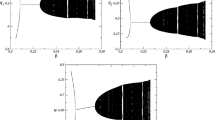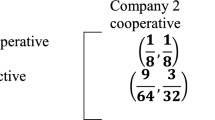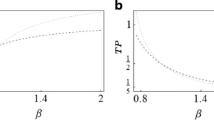Abstract
In this paper, we reconsider the model in Bischi and Lamantia (J Econ Interact Coord 17:3–27, 2022) and reformulate it in a two-population context. There, the Cournot duopoly market examined is in equilibrium (Cournot-Nash-equilibrium quantities are produced) conditionally to the players’ (heterogeneous) attitudes toward cooperation. To accommodate players’ attitudes, their objective functions partly include the opponent’s profit, resulting in greater (partial) cooperation or hostility toward the opponent than in the standard duopoly setting. An evolutionary selection mechanism determines the survival of cooperative or competitive strategies in the duopoly. The game is symmetric and Bischi and Lamantia (J Econ Interact Coord 17:3–27, 2022) assumes that the two players involved start the game by choosing the same strategic profile. In this way, the full-fledged two-population game simplifies in a one-dimensional map. In this paper, we relax this assumption. On one hand, this approach allows us to investigate entirely the dynamics of the model and the evolutionary stability of the Nash equilibria of the static game that is implicit in the evolutionary setup. In fact, the model with only one population partially represents the system dynamics occurring in an invariant subset of the phase space. As a remarkable result, this extension shows that the steady state of the evolutionary model where all players are cooperative can be an attractor, although only in the weak sense, even when it is not a Nash equilibrium. This occurs when firms have a very high propensity to change strategies to the one that performs better. On the other hand, this approach allows us to accommodate players’ heterogeneity (non-symmetric version of the game), whose analysis confirms the main insights attained in the homogeneous setting.






Similar content being viewed by others
Notes
All the mentioned contributions, as well as most evolutionary games in economics, assume interactions among agents from infinite populations of players. A different approach to explaining the selection of cooperation in evolutionary games is based on strategic interaction from a finite population of players. Nowak and Sigmund (2005) report stronger forms of reciprocity that can lead to more cooperation with finite populations. In this work, however, we still consider infinite populations of agents.
In this context, optimality is referred to from the industry perspective while the consumer standpoint is left out. An evolutionary model in the spirit of this paper with the incorporation of shares of the consumer objective function into the firms’ objective has been proposed in Kopel et al. (2014). For an examination of possible alternative objectives to profit (without levels of aggression/cooperation) we refer to Fanti et al. (2017).
Clearly a non-negativity constraint should be included in the price. However, we omit it because it is verified ex-post in the equilibrium quantities considered in the model.
In Bischi and Lamantia (2022), to accommodate memory, the function F also accounts for past profits. Here, we neglect the role of memory and we instead focus on the two-population version of the evolutionary game.
Consider map (21). If \(E_{0,0}\) is locally asymptotically stable, it must attract all points that lie in a neighborhood of it, which includes also points in the diagonal \(m_{1}=m_{2}\) where the dynamics is conjugated to the one of (23), therefore \(E_{0}\) is also locally asymptotically stable. Assume that \(E_{0}\) is also locally asymptotically stable for (23). Since the dynamics of (21) is conjugated to the one of (23) on \(m_{1}=m_{2}\), all points in a neighborhood of \(E_{0,0}\) that lie in the diagonal are attracted to \(E_{0,0}\). Then, \(E_{0,0}\) is either a saddle or a stable equilibrium. However, to be a saddle, it is required that \(m_{1}=m_{2}\) is an eigenvector (stable manifold) of the equilibrium. However, the eigenvectors of \(E_{0,0}\) are the left and right borders of \(\left[ 0,1\right] ^{2}\). It follows that \(E_{0,0}\) must be a stable equilibrium.
References
Anufriev, M., & Kopányi, D. (2018). Oligopoly game: Price makers meet price takers. Journal of Economic Dynamics & Control, 91(91), 84–103.
Anufriev, M., Radi, D., & Tramontana, F. (2018). Some reflections on past and future of nonlinear dynamics in economics and finance. Decisions in Economics and Finance, 41, 91–118.
Ashwin, P., Buescu, J., & Stewart, I. (1996). From attractor to chaotic saddle: A tale of transverse instability. Nonlinearity, 9(3), 703–737.
Baiardi, L. C., & Naimzada, A. (2019). An evolutionary Cournot oligopoly model with imitators and perfect foresight best responders. Metroeconomica, 70, 458–475.
Bischi, G. I., & Lamantia, F. (2022). Evolutionary oligopoly games with cooperative and aggressive behaviors. Journal of Economic Interaction and Coordination, 17, 3–27. https://doi.org/10.1007/s11403-020-00298-y
Bischi, G. I., Chiarella, C., Kopel, M., & Szidarovszky, F. (2010). Nonlinear oligopolies: Stability and bifurcations. Springer-Verlag.
Bischi, G. I., Lamantia, F., & Radi, D. (2015). An evolutionary Cournot model with limited market knowledge. Journal of Economic Behavior & Organization, 116, 219–238.
Bischi, G.I., Lamantia, F., & Radi, D. (2018). Handbook of game theory and industrial organization, volume I, theory, elgar, chap evolutionary oligopoly games with heterogeneous adaptive players. EISBN: 978 1 78536 328 3
Buescu, J. (1997). Exotic Attractors. Birkhäuser.
Cabrales, A., & Sobel, J. (1992). On the limit points of discrete selection dynamics. Journal of Economic Theory, 57(2), 407–419.
Cerboni Baiardi, L., Lamantia, F., & Radi, D. (2015). Evolutionary compentition between boundedly rational behavioral rules in oligopoly games. Chaos, Solitons & Fractals, 79, 204–225.
Cheng, S.F., Reeves, D., Vorobeychik, Y., & Wellman, M. (2004). Notes on equilibria in symmetric games. In Proceedings of the 6th international workshop on game theoretic and decision theoretic agents GTDT 2004, pp. 71–78
Clayton, M. J., & Jørgensen, B. (2005). Optimal cross holding with externalities and strategic interactions. The Journal of Business, 78(4), 1505–1522.
Cressman, R., & Tao, Y. (2014). The replicator equation and other game dynamics. Proceedings of the National Academy of Sciences (PNAS), 111(3), 10,810-10,817.
Cyert, R., & DeGroot, M. H. (1973). An analysis of cooperation and learning in a duopoly context. American Economic Review, 63(1), 24–37.
De Giovanni, D., & Lamantia, F. (2016). Control delegation, information and beliefs in evolutionary oligopolies. Journal of Evolutionary Economics, 27(5), 877–903.
Devaney, R. L. (1989). An introduction to chaotic dynamical systems. CRC Press.
Droste, E., Hommes, C. H., & Tuinstra, J. (2002). Endogenous fluctuations under evolutionary pressure in Cournot competition. Games and Economic Behavior, 40(2), 232–269.
Fanti, L., Gori, L., & Sodini, M. (2017). Managerial delegation theory revisited. Managerial and Decision Economics, 38(4), 490–512.
Fershtman, C., & Judd, K. L. (1987). Equilibrium incentives in oligopoly. American Economic Review, 77(5), 927–940.
Friedman, D. (1991). Evolutionary games in economics. Econometrica, 59(3), 637–666.
Gardini, L., Schmitt, N., Sushko, I., Tramonatana, F., & Westerhoff, F. (2021). Necessary and sufficient conditions for the roots of a cubic polynomial and bifurcations of codimension-1, -2, -3 for 3D maps. Journal of Difference Equations and Applications, 27(4), 557–578.
Harting, P., & Radi, D. (2020). Residential segregation: The role of inequality and housing subsidies. Journal of Economic Behavior & Organization, 178, 801–819.
Hofbauer, J., & Sigmund, K. (1998). Evolutionary games and population dynamics. Cambridge University Press.
Hofbauer, J., & Sigmund, K. (2003). Evolutionary game dynamics. Bulletin (New Series) of the American Mathematical Society, 40(4), 479–519.
Hofbauer, J., & Weibull, J. W. (1996). Evolutionary selection against dominated strategies. Journal of Economic Theory, 71(2), 558–573.
Hommes, C., & Zeppini, P. (2014). Innovate or imitate? Behavioural technological change. Journal of Economic Dynamics & Control, 48, 308–324.
Hommes, C. H., Ochea, M. I., & Tuinstra, J. (2018). Evolutionary competition between adjustment processes in Cournot oligopoly: Instability and complex dynamics. Dynamic Games and Applications, 8, 822–843.
Königstein, M., & Müller, W. (2000). Combining rational choice and evolutionary dynamics: The indirect evolutionary approach. Metroeconomica, 51(3), 235–256.
Königstein, M., & Müller, W. (2001). Why firms should care for customers. Economics Letters, 72(1), 47–52.
Kopel, M., & Lamantia, F. (2018). The persistence of social strategies under increasing competitive pressure. Journal of Economic Dynamics & Control, 91, 71–83.
Kopel, M., Lamantia, F., & Szidarovszky, F. (2014). Evolutionary competition in a mixed market with socially concerned firms. Journal of Economic Dynamics & Control, 48, 394–409.
Lamantia, F., & Radi, D. (2018). Evolutionary technology adoption in an oligopoly market with forward-looking firms. Chaos, 28(5), 055,904.
Mignot, S., Tramontana, F., & Westerhoff, F. (2023). Complex dynamics in a nonlinear duopoly model with heuristic expectation formation and learning behavior. Annals of Operations Research. https://doi.org/10.1007/s10479-023-05497-x
Nowak, M., & Sigmund, K. (2005). Evolution of indirect reciprocity. Nature, 437, 1291–1298.
Radi, D. (2017). Walrasian versus Cournot behavior in an oligopoly of bounded rational firms. Journal of Evolutionary Economics, 27(5), 933–961.
Vega-Redondo, F. (1997). The evolution of Walrasian behavior. Econometrica, 65(2), 375–384.
Weibull, J. (1997). Evolutionary game theory. MIT Press.
Acknowledgements
We thank the Editors and two anonymous Referees for their valuable and constructive feedback on our paper. The authors acknowledge the financial support from the Czech Science Foundation (GACR) under project 23-06282S, and an SGS research project of VŠB-TUO (SP2023/19). The financial support of the European Union under the REFRESH – Research Excellence For REgion Sustainability and High-tech Industries project number CZ.10.03.01/00/22_003/0000048 via the Operational Programme Just Transition is acknowledged as well.
Funding
The authors acknowledge the financial support from the Czech Science Foundation (GACR) under project 23-06282S, and an SGS research project of VŠB-TUO (SP2023/19). The financial support of the European Union under the REFRESH – Research Excellence For REgion Sustainability and High-tech Industries project number CZ.10.03.01/00/22_003/0000048 via the Operational Programme Just Transition is acknowledged as well.
Author information
Authors and Affiliations
Contributions
All the steps needed to complete this manuscript were done by all three authors.
Corresponding author
Ethics declarations
Conflict of Interest
The authors declare that they have no conflict of interest.
Additional information
Publisher's Note
Springer Nature remains neutral with regard to jurisdictional claims in published maps and institutional affiliations.
Rights and permissions
Springer Nature or its licensor (e.g. a society or other partner) holds exclusive rights to this article under a publishing agreement with the author(s) or other rightsholder(s); author self-archiving of the accepted manuscript version of this article is solely governed by the terms of such publishing agreement and applicable law.
About this article
Cite this article
Lamantia, F., Radi, D. & Tichy, T. Two-Population Evolutionary Oligopoly with Partial Cooperation and Partial Hostility. Comput Econ (2024). https://doi.org/10.1007/s10614-023-10536-7
Accepted:
Published:
DOI: https://doi.org/10.1007/s10614-023-10536-7




